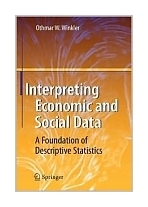|
||
podział tematyczny • wydawnictwa anglojęzyczne podział tematyczny Newsletter: • Zamów informacje o nowościach z wybranego tematu Informacje: • sposoby płatności i dostawy • kontakt • Cookies na stronie • Regulamin zakupów Napisz propresssp@gmail.com |
INTERPRETING ECONOMIC AND SOCIAL DATA: A FOUNDATION OF DESCRIPTIVEWINKLER O. W. / STATISTICSwydawnictwo: SPRINGER , rok wydania 2009, wydanie Icena netto: "Interpreting Economic and Social Data" aims at rehabilitating the descriptive function of socio-economic statistics, bridging the gap between today's statistical theory on one hand, and econometric and mathematical models of society on the other. It does this by offering a deeper understanding of data and methods with surprising insights, the result of the author's six decades of teaching, consulting and involvement in statistical surveys. The author challenges many preconceptions about aggregation, time series, index numbers, frequency distributions, regression analysis and probability, nudging statistical theory in a different direction. "Interpreting Economic and Social Data" also links statistics with other quantitative fields like accounting and geography. This book is aimed at students and professors in business, economics demographic and social science courses, and in general, at users of socio-economic data, requiring only an acquaintance with elementary statistical theory. Table of Contents 284 pages, Hardcover Księgarnia nie działa. Nie odpowiadamy na pytania i nie realizujemy zamówien. Do odwolania !. |


